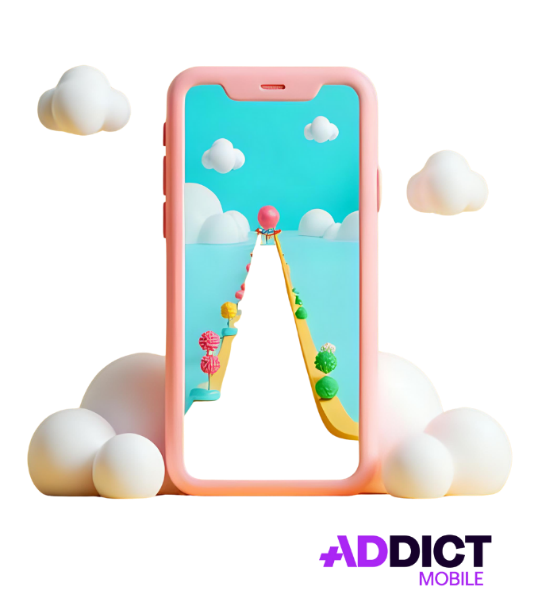Playable Ads: Definition, Benefits & Best Practices
Introduction
Playable Ads transform the ad experience by allowing users to try out an app, often a game, before downloading it. This innovative format stands out for its immersive and engaging nature, making it a go-to performance lever for mobile marketers aiming to boost results. Let’s break it down.
What are Playable Ads?
Definition
A Playable Ad is an interactive ad format that gives users a functional preview of an app, often through a mini-game or dynamic demo, directly within the ad placement. The goal: drive installs by letting users try the app before downloading it.

Playable Ad Formats
- Interactive mini-games: simplified versions of a mobile game.
- Guided demo: a walkthrough highlighting key features.
- Product simulation: useful beyond gaming (e.g., photo editing, productivity, fintech apps).
- Integrated call-to-action: buttons like “Play Now,” “Try,” or “Install” included in the flow.
Core Mechanics of Playable Ads
- Engagement mechanics: virtual rewards, short challenges, high-score incentives
- Interactive mechanics: drag-and-drop, tap sequences, dynamic mini-tutorials

Why Use Playable Ads?
Playable Ads serve multiple strategic goals in mobile user acquisition. Here are a few key benefits:
Brand Awareness: Make the message stick through interaction
Unlike passive formats like banners or standard videos, Playables actively involve the user. Interacting with the product makes the brand message more memorable.
📊 According to a 2023 Liftoff x GameRefinery study, interactive formats generate 2.5x higher ad recall than traditional formats.
Example: a meditation app offering a short breathing exercise inside the ad leaves a stronger impression than a basic video spot.
Engagement: Stand out in a saturated ad environment
Playables consistently drive higher engagement rates than standard formats. By delivering a playful experience, users don’t just watch, they interact.
Playable Ads often generate 15 to 30 seconds of interaction time, compared to just 5 to 7 seconds for typical video ads (source: ironSource, 2023).
Example: an e-commerce app ad where users can build a custom outfit gets more attention than a simple product showcase.
Conversion: Pre-qualify your users
Letting users test the app before they install it helps filter out low-intent users. Those who do install are already engaged and know what to expect.
📊 Campaigns using Playables show up to 3x higher CVR and 30–40% lower CPI compared to traditional videos (Unity Ads Benchmarks, 2023).
Example: a player who completes a Playable demo is much more likely to invest time in the full game post-install.
Audience Fit: Attract high-quality users
The interactive experience acts as a natural filter. Users who engage and install are often those whose interests and behaviors match the app’s value proposition.
📊 According to AppsFlyer, users acquired via Playables show a 1.5x higher ROAS on average within the first 7 days post-install.
Example: for a trading app, an interactive tutorial draws in finance-savvy users, not just casual browsers.
Benefits of Playable Ads
In an increasingly competitive landscape, it’s essential to stand out to avoid ad fatigue and wasted media spend. While Playable Ads may require more effort to produce and deploy, they offer a number of advantages worth considering when building your media mix.
Higher Install and Retention Rates
Playable Ads excel at delivering quality installs and improving user retention:
- High install rate: Playables are over 20x more likely to drive an install than traditional banner ads (Source: Digiday)
- Improved retention: Brands and publishers have seen 30–40% increases in retention rates thanks to Playable formats (Source: Applovin)
- Lower CPI: Playable Ads often outperform static and video formats in terms of cost per install, especially on ad networks (Source: Appsflyer)
Access to Valuable Behavioral Insights
Playables provide a wealth of data on user behavior, even before the app is installed:
- Interaction analytics: They allow detailed tracking of user actions, offering valuable insights into preferences and engagement. (Source: Native Advertising Institute)
- Campaign optimization: Data collected from Playables can be used to improve ad placements and tailor content for specific audience segments. (Source: PlayableMaker)
- Enhanced user experience: By gaining a clearer understanding of user behavior, advertisers can fine-tune in-app experiences, deliver more relevant and personalized ads, and launch smarter acquisition strategies that drive not only installs, but also long-term engagement and revenue growth. (Source: PlayableMaker)
Key KPIs to Monitor for a High-Performing Playable Ad
- Completion rate: % of users who finish the interactive demo
- CTR (Click-through Rate): click rate on the install CTA
- IR (Install Rate): ratio of clicks to actual installs
- D1 / D7 Retention: user retention rates from Playable-driven installs
- Time spent: average time spent within the ad
- Engagement rate: % of interactions per user
How to Build a Playable Ad
Creating a high-performing Playable Ad requires a combination of technical skills, a solid grasp of the marketing message, smooth UX, and performance-driven thinking. Here’s a recommended approach:
Methodology
Step 1: Define the ad’s primary objective
Before building the format, clarify the Playable’s main goal:
- Drive qualified installs?
- Improve retention?
- Highlight a key feature?
- Validate gameplay comprehension?
🎯 Example: a quiz app might want to showcase the variety of themes or a “duel” mode mechanic.
Step 2: Design the interactive sequence
La séquence doit être courte (10 à 30 secondes), intuitive et représentative du cœur de l’app. L’utilisateur doit comprendre en quelques clics ce qu’il peut attendre de l’expérience complète.
Examples:
- Mobile games: a quick puzzle, a basic level, or a one-round battle
- E-commerce apps: configure a product or explore a selection
- Finance apps: simulate a return or fill out a simplified form
🔄 Tip: better to keep the experience simple and focused than to try showing everything.
Step 3: Build the interactive prototype
Key elements include:
- Lightweight graphics and animated sprites adapted to ad size constraints
- A smooth, reactive UX — no loading time, immediate visual feedback after every interaction
- A clear CTA at the end (e.g., “Play Now,” “Download,” “Get Started”)
🎨 Tools used:
- Figma for static mockups
- Unity, Buildbox, or SDKs from ad networks like ironSource or AppLovin for interactive builds
- No-code platforms like Playable Factory or Kaizen Ad for faster prototyping
Step 4: Integrate and run A/B tests
Performance comes from iteration. Test:
- Different onboarding flows (with or without tutorial)
- Varying difficulty levels
- Multiple CTA designs and end screens
📊 It’s recommended to launch several creative variants early and track completion, engagement, and conversion KPIs closely.
Examples of successful Playable Ads
💰 Rewards App – Cashback Experience (e.g., Pogo)
Tested mechanic: tap to simulate claiming rewards or cashback from recent purchases
UX Best Practices for Playables
- Immediate feedback (light animations, sound effects)
- Short interactions (<30 seconds)
- Clear instructions (“Swipe to play,” “Tap here”)
- Loading time under 2 seconds
- CTA fully integrated into the gameplay
Conclusion
Playable Ads are no longer limited to mobile games, they’ve become a powerful tool for audience qualification, engagement, and conversion across a wide range of verticals. With their immersive format and valuable behavioral insights, Playables help marketers build campaigns that are more relevant, more effective, and more profitable.


